
Moringa peregrina / شوع
Hyperanthera peregrina Forssk
Alban, Yasar, Baan, Leban, Alleban, Alhaba Alghaliah
Ben tree, Wispy-needled yasar tree, Wild drum-stick tree
Shu’a
Moringaceae

Flowers

Herbarium specimen
Ethnobotanical Characteristics
Description
Tree, up to 6m. branches drooping, bluish-green, leafless for most of the year. Leaves coming out at the beginning of the flowering season, 2-3-pinnate, alternate, up to 30cm long; leaflets opposite, 10-20mm oblong. Flowers pink, in large panicles, fragrant. Sepals and petals 5. Fruit 10-30cm, cylindrical, dehiscing by 3 valves. It is a small graceful tree growing up to about 10m, with narrow, pendulous branches. It is often leafless but the leaves when present are large and pinnately-divided into almost liner, blue-green leaflets. The fruits are narrowly cylindrical, up to about 30cm long, and marked with deep longitudinal grooves.
Habitat and Distribution
Moringa peregrina is distributed in North East equatorial Africa, throughout Arabia and as far north as Syria. Usually grows in mountain slopes up to 800 m; very common in the UAE at low to intermediate elevations, especially in Ruus Al Jibal, where it is dominant tree on steep slopes; also scattered throughout Fujairah at higher altitudes, and on upper flanks of Jebel Hafit (Gazanfar, 1994; Western, 1989).
Part(s) Used
Seeds and oil obtained from seed
Traditional and Medicinal Uses
Oil (hal al shu’) is traditionally used to treat headache, fever, abdominal pain and constipation, burns, back and muscle pains and during labor in childbirth. The pure oil is used for headache, fever, burns, lacerations and bone fractures. It is also applied to relieve stiffness in the back and other muscle pain and on the scalp to cure dryness. Cosmetically, the oil is used on the body and face to soften skin or taken internally for constipation and abdominal pain. Leaf extract is rubbed over skin to soothe rash.
The bean oil has been used by the Egyptians since old and middle kingdoms. In the north of Oman, oil extracted from the pods was used in the treatment of infantile paralysis or infantile convulsions, and in the Yemen the same oil was used as an unguent. Early Greek physicians recommended the use of Moringa to treat ailments of the stomach, leprosy, pustules on the face and for the relief of itching. An early Muslim source speaks of the oil extracted from the pods being used in perfumery, and the material remaining from the extraction of the oil being beneficial in the treatment of various skin ailments, as well as in the removal of freckles and in the treatment of itching. An extraction was prescribed for encouraging facial and head hair to grow long and strong, and to treat nosebleeds as well as diseased teeth and gums. (Gazanfar, 1994, Batanouny, 1999, Miller, 1988).
Pharmacognosy and Phytochemistry
General appearance
hick branches are almost cylindrical in outline. They are covered with a dark violet brown bark and the hard wood is light yellow in colour. The small branches and twigs are slender, cylindrical, and brittle and they are light violet brown in colour.
Microscopical characteristics
A sectional view through the branch shows that the epidermal layer is composed of rounded or slightly square shaped cells with thick cell walls underlain by many layers of yellow cortical compressed small parenchyma cells, which are underlain by layers of larger yellow distorted cortical parenchyma cells interrupted by groups of isolated lignified fibers. These cells also enclose isolated vascular tissues whose xylem vessels and tracheids are heavily lignified. The parenchyma of the xylem tissues is large and oblong in shapes and they contain characteristic large orange masses that separate into solution as oblong entities. The central zone is occupied by large parenchyma of the pith which is rounded or oblong in shape, with pitted cell walls. These cells are quite rich in translucent rounded masses.
Powdered plant material
The material consists of a yellowish-green, fine powder of the branches. It has an acrid, somewhat astringent taste, reminiscent of dried wheat leaf powder and an odour like that of dried straw powder. Microscopically, the powder shows large oblong orange masses free or contained in the large oblong parenchyma cells of the xylem tissues. Also shown are the pith large rounded and oblong cells with pitted cell walls, in addition to groups of long fibers.
Parts studied
stem

A) Stem epidermis
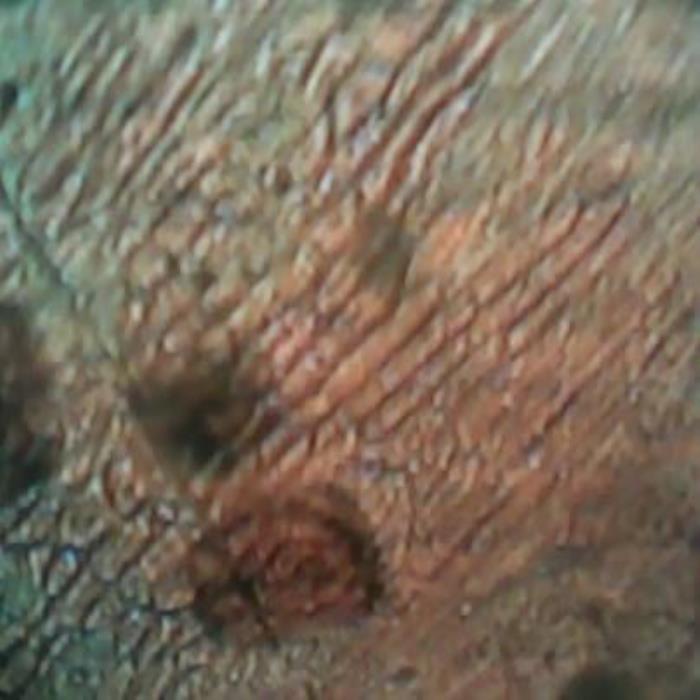
B) Surface view of stem
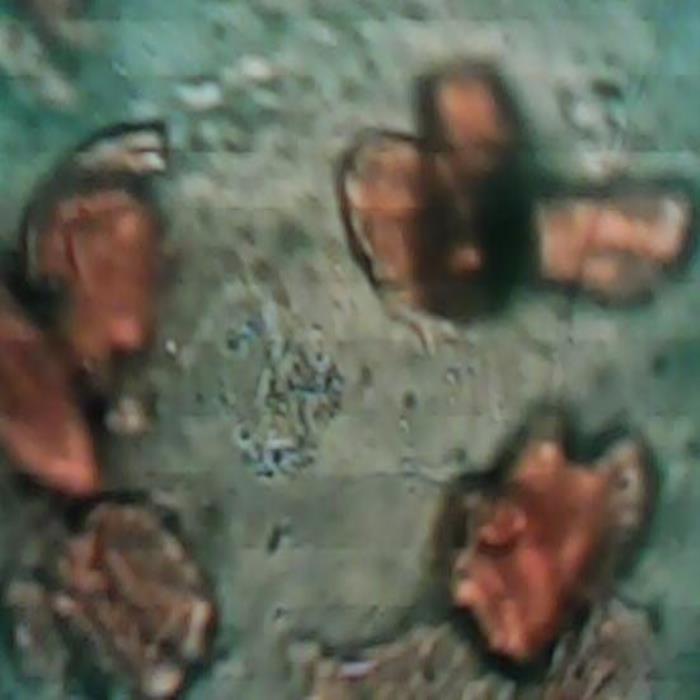
C) Orange masses
- A. Surface of the stem epidermis from below showing the rounded or slightly square-shaped cells.
- B. A surface view of the stem in an oblique way showing the rounded or square-shaped parenchyma cells to follow an ordered pattern of straight lines as if they were forming narrow oblong cellular arrangements.
- C. The characteristic large orange masses that separate as oblong entities from the large parenchyma of the xylem tissues.
Chemical constituents
The fatty acids composition in extracted oil from the seeds is as follows: palmitic 9.3%, palmitoleic 2.4%, stearic 3.5%, oleic 78.0%, linoleic 0.6%, linolenic 1.6%, arachidic 1.8% and behenic 2.6% (Somali, 1984). Aerial parts contain flavonoid compounds: quercetin, quercetin-3-O-rutinoside (rutin), chrysoeriol-7-O-rhamnoside and 6, 8,3´,5´-tetramethoxy apigenin (Seham, 1984). Flavonoids, tannins, sterols and \or triterpenes and saponins are reported from the aerial parts (Al-Yahya 1990).Six active constituents: lupeol acetate, α-amyrin, β-amyrin, β-sitosterol, β-sitosterol-3-O-β-D-glucoside and apigenin are also reported from aerial parts( Abdel-Rahman, 2010).
The following chemical studies have been carried out on the seeds of the plant Moringa peregrine (Quality Control methods, 1998; Evans, 1996, ZCHRTM unpublished work)
Physicochemical constants
Loss of weight in drying at 105°C : 11.20
Absolute alcohol solubility : 7.20
Water solubility : 16.00
Successive extractives (%)
Petroleum ether (60-80) °C : 3.05
Chloroform : 2.40
Absolute alcohol : 10.35
Successive aqueous extract : 11.55
Ash values (%)
Total ash : 7.33
Water soluble ash : 3.67
Acid insoluble ash (10% HCl) : Nil
pH values (aqueous solution)
pH of 1% solution : 5.362-5.382
pH of 10% solution : 4.932-4.936
Elemental analyses
Ash values (British Herbal Pharmacopeia)
Assay and identification of element (AOAC International)
|
Apparatus |
AA-6800 Shimadzu-Flame method |
||||
| Element | Std. conc. µg/ml | Sample conc.mg/ml | Sample absorbance | Actual conc.mg/ml | Actual conc. (%) |
|
Cr |
1, 2, 4 |
10 |
0.0077 |
0.00688 |
0.000688 |
|
Zn |
0.25, 0.5, 1 |
10 |
0.0576 |
0.01022 |
0.001022 |
|
Cu |
1, 2, 4 |
10 |
0.0209 |
0.00933 |
0.000933 |
|
Fe |
1, 2, 4 |
10 |
0.2948 |
0.2088 |
0.02088 |
|
K |
1, 2, 4 |
0.5 |
0.5459 |
19.7568 |
1.97568 |
|
Pb |
1, 2, 4 |
10 |
0.0492 |
0.00492 |
0.000492 |
|
Cd |
0.25, 0.5, 1 |
10 |
0.0000 |
0.0000 |
0.0000 |
|
Ca |
5, 10, 20 |
10 |
0.0434 |
1.39316 |
0.139316 |
UV Spectral studies
|
Ultraviolet Spectrum (USP reference) |
||||
|
Apparatus |
Milton Roy Spectronic Genesys 5 Spectrophotometer - Milton Roy. |
|||
|
Sample conc. (mg / ml) |
Solvent |
λ max (nm) |
λ min (nm) |
Abs.( λ max - λ min) |
|
1.255 |
Intestinal Fluid simulated without pancreatic pH=7.50.1 |
277 |
259 |
1.148 - 0.890 |
|
1 |
Gastric Fluid simulated without pepsin pH =1.20.1 |
280 229 |
259 - |
1.175 - 0.856 3.444 |
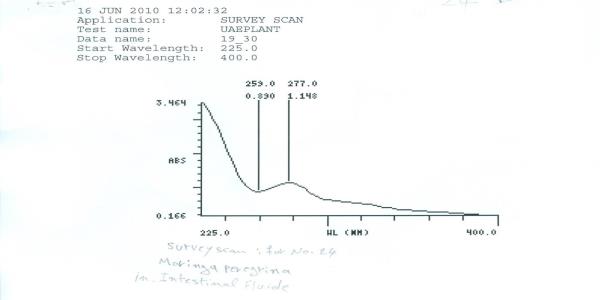
Intestinal Fluid simulated without pancreatic
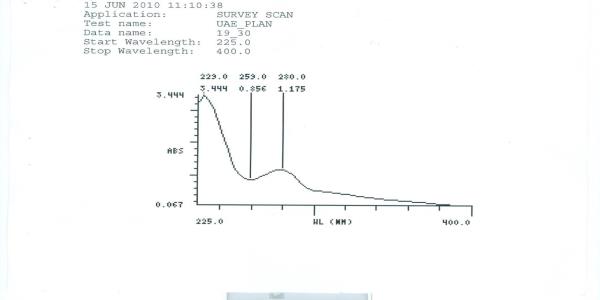
Gastric fluid simulated without pepsin
Chromatographical Studies
Thin layer chromatography (TLC): Wagner and Bladt, 1996
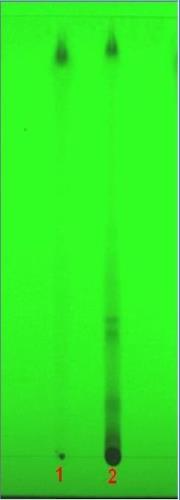
A
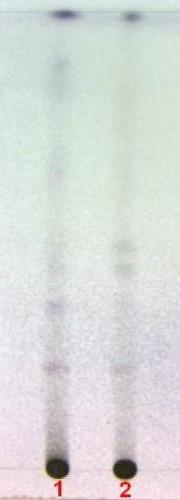
B
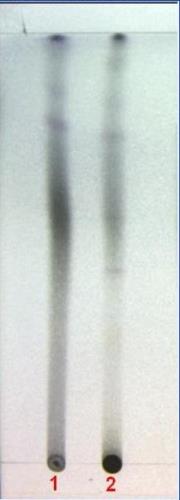
C
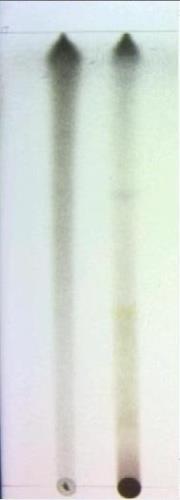
D
TLC fingerprint of Petroleum ether 60-80°C (track 1) and MeOH extract (track 2)
|
Mobile phase Fig. |
A&D |
: |
Ethyl acetate, methanol, water (100:13.5:10) |
|
|
B |
: |
Toluene, ethyl acetate (93:7) |
|
|
C |
: |
Toluene, ethyl formate, formic acid (5:4:1) |
|
Detection |
A |
: |
UV 254nm |
|
Derivatization |
B, C&D |
: |
Vanillin-Sulphuric acid-vis |
The toxicological and pharmacological Studies
Based on published research, Moringa oleifera is one of the important medicinal plant known for a wide range of pharmacological activities (Mossa, 1985; William 1993) including anti-diabetic activity (Kar, 1999) , hepato-protective activity (Ruckmani, 1998); anticancer activity (Murakami, 1998; Guevara, 1999; Gupta et al., 1997); Anti-Mutagenic potential (Grabow, 1985); Antiepileptic activity (Guevara, 1999); Antibacterial activity (Rajendhran,1998; Singha, 1993; Spiliotis, 1998; Caceres, 1991); Antifungal activity (Nwosu, 1995); Antipyretic activity (Singh, 1999); Hypotensive activity (Faizi, 1992; 1998); Steroid depressed healing and regulation of thyroid hormone levels (Udupa,1998; Tahiliani, 1999); Antispasmodic, anti-inflammatory and diuretic activities (Caceres, 1992; Udupa, 1994; Ezeamuzie , 1996); Anti-fertility activity (Mathur, 1988); CNS stimulant (Gupta , 1999); and in the treatment of pyoderma (Caceres , 1991).
Makkar, (1996) and Gupta, (1989) studied the plant nutritional of Moringa oleifera leaves and pods and found to be extremely valuable source of nutrition for people of all ages. For a child aged 1-3, a 100-gram serving of fresh leaves would provide all the daily requirements of calcium, about 75% of iron and half the total protein needs, as well as potassium, B complex vitamins, copper and all the essential amino acids. As little as 20 grams of fresh leaves would provide a child with all the vitamins A and C needed.
For pregnant and breast-feeding women, Moringa leaves and pods preserve the mother's health and pass on strength to the fetus or nursing child. For both infants and mothers, pods can be an important source of fiber, potassium, copper, iron, choline, vitamin C and all the essential amino acids. The high concentrations of iron, protein, copper, various vitamins and essential amino acids present in Moringa leaves make it virtually ideal nutritional supplement.
The following pharmacological and safety evaluation studies were carried out on the plant extract of Moringa peregrina (Aerial parts) (Derelanko 2002; Han, 2003).
|
ACTIVITY |
RESULTS |
|||
|
Strong |
Moderate |
Mild |
Negative |
|
|
Analgesic (Writhing) |
|
√ |
|
|
|
Antidepressant |
|
|
|
√ |
|
Anti-gastric ulcer activity |
√ |
|
|
|
|
Cyto-protective activity |
√ |
|
|
|
|
Anti-inflammatory (Ear edema) |
|
|
√ |
|
|
Anti-inflammatory (cotton pellet) |
|
√ |
|
|
|
Anti-stress (Swim endurance test) |
|
√ |
|
|
|
Anti-diabetic activity (STZ & GTT) |
|
|
√ |
|
|
Effect on rabbit jejunum |
|
√ |
|
|
|
Effect on rat fundus |
√ |
|
|
|
|
Effect on Guinea pig ileum |
|
√ |
|
|
|
Effect on Guinea pig tracheal chain |
|
|
|
√ |
|
Effect on rat aorta |
√ |
|
|
|
|
Anesthetized rat (BP & HR) ↓ |
√ |
|
|
|
|
Erectile activity (corpus cavernous strip) |
|
√ |
|
|
|
Sexual stimulant (ICP) |
|
√ |
|
|
|
Uterotropic |
|
|
|
√ |
|
Hepato-protective activity |
√ |
|
|
|
|
Hematological studies (WBC & MCHC) ↓ |
|
|
√ |
|
|
Locomotor activity test |
|
|
√ |
|
|
Motor co-ordination (grip strength & motor activity |
|
|
|
√ |
|
Rectal temperature |
|
|
|
√ |
|
Body weight |
|
|
|
√ |
|
Plasma glucose |
|
|
|
√ |
|
Effect on Urine |
|
|
|
√ |
|
Mortality |
|
|
|
√ |
|
LD50 |
> 5G/KG |
|||
Summary of results
The aqueous extract of Moringa peregrina (Aerial parts) showed moderate anti-inflammatory activity following single dose administration. The plant extract showed positive mild analgesic activity, Antidiarrheal activity. The plant extract showed very significant antigastric ulcer activity.
The plant extract showed positive anti-diabetic activity. The extract was found effective as Anti-depressant. The plant extract was screened for sexual stimulant potential showed increased erectile activity and positive cardio tonic activity. The plant extract was studied for hepato-protection, showed significant protective action made evident by its effect on the levels of liver enzymes.
The LD50 studied in mice was >5 g/kg showing the safety of the plant. The plant extract showed no toxic signs and no mortality was recorded.
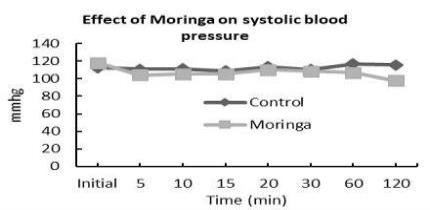
Effect on systolic blood pressure
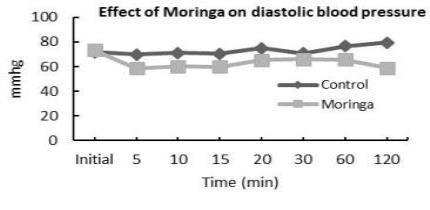
Effect of diastolic blood pressure
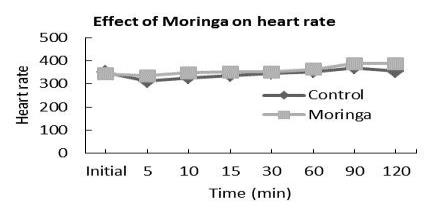
Effect on heart rate
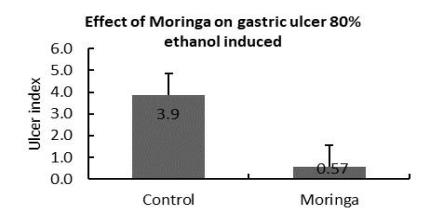
Effect on gastric ulcer
Antimicrobial activity
The aqueous extract of the whole plant was tested against Mycobacterium smegmatis, C. tropicalis, Streptococcus pyogenes, different strains of Staphylococcus aureus (Including ATCC 257), different strains of Methicillin Resistant Staphylococcus aureus (MRSA), different strains of E. coli (Including ATCC UN 109), different strains of ESBL-producing K. pneumonia, E. coli, Pseudomonas aeruginosa. The extract showed very strong antibacterial.
References
- A.R.Western. The flora of the United Arab Emirates – an introduction, UAE University Press, p.123, 1989.
- Al- Yahya MA, Al- Meshal IA, Mossa JS, Al- Badr AA, Tariq M. Saudi Plants: A Phytochemical and Biological Approach. king abdulaziz city for science and technology ,1990. P.289
- Caceres, A. and S. Lopez. Pharmacological properties of Moringa oleifera: 3. Effect of seed extracts in the treatment of experimental pyodermia. Fitoterapia, 1991, 62: 449-450.
- Caceres, A., and A. Saravia, et al. Pharmacologic properties of Moringa oleifera: 2: Screening for antispasmodic, anti-inflammatory and diuretic activity. Journal of Ethnopharmacology, 1992, 36: 233-237.
- Caceres, A., O. Cabrera, et al. Pharmacological properties of Moringa oleifera: 1. Preliminary screening for antimicrobial activity. Journal of Ethnopharmacology, 1991, 33: 213-216.
- El-Ghonemy, A. A. (1993). Encyclopedia of Medicinal plants of the United Emirates. 1st Edition. University of U.A.E.
- Ezeamuzie, I. C., A. W. Ambakederemo, et al. Antiinflammatory effects of Moringa oleifera root extract. International Journal of Pharmacognosy, 1996, 34: 207-212.
- Faizi, S., B. S. Siddiqui, et al. Hypotensive constituents from the pods of Moringa oleifera. Planta Medica, 1998, 64: 225-228.
- Faizi, S., B. S. Siddiqui, et al. Isolation and structure elucidation of novel hypotensive agents, niazinin A, niazinin B, niazimicin and niaziminin A plus B from Moringa oleifera: The first naturally occurring thiocarbamates. Journal of the Chemical Society Perkin Transactions, 1992, 1: 3237-3241.
- Fawzi, M. K. (1995). Weeds in the United Arab Emirates. University of U.A.E.
- Grabow, W. O. K., J. L. Slabbert, et al. Toxicity and mutagenicity evaluation of water coagulated with Moringa oleifera seed preparations using fish, protozoan, bacterial, coliphage, enzyme and Ames Salmonella assays. Water S A, 1985, 11: 9-14.
- Guevara, A. P., C. Vargas, et al. An antitumor promoter from Moringa oleifera Lam. Mutation Research, 1999, 440: 181-188.
- Gupta, K., G. K. Barat, et al. Nutrient contents and antinutritional factors in conventional and non-conventional leafy vegetables. Food Chemistry, 1989, 31: 105-116.
- Gupta, M., U. K. Mazumder, et al. Anti-epileptic and anti-cancer activity of some indigenous plants. Indian Journal of Physiology and Allied Sciences, 1997, 51: 53-56.
- Gupta, M., U. k. Mazumder, et al. CNS activities of methanolic extract of Moringa oleifera roots in mice. Fitoterapia, 1999, 70: 244-250.
- James P. Mandaville. Flora of Eastern Saudi Arabia. The Gresham Press, London. p.254, 1990.
- Jonbloed, M. V., Feulner, G. R., Boer, B. & Western, A. R. (2003).
- The comprehensive Guide to the Wild Flowers of the United Arab Emirates, Erwda, Abu Dhabi, U.A.E.
- K.H. Batanouny. Wild medicinal plants in Egypt, Academy of Sci. Res. & Tech., p. 151, Egypt, 1999
- Kar, A., B. K. Choudhary, et al. Preliminary studies on the inorganic constituents of some indigenous hypoglycaemic herbs on oral glucose tolerance test. Journal of Ethnopharmacology, 1999, 64: 179-184.
- Loutfy Boulos. Medicinal plants of North Africa, Reference Publications, USA, p.37, 1983.
- M. A. Abdel-Rahman Tahany, A. K. Hegazy, A. Mohsen Sayed, H. F. Kabiel, T. El-Alfy and S. M. El-Komy. Study on combined antimicrobial activity of some biologically active constituents from wild Moringa peregrina Forssk. Journal of Yeast and Fungal Research Vol. 1(1) pp. 015-024, February, 2010.
- M.A. SOMALI, M.A. BAJNEID and S.S. AL-FHAIMANI. Chemical Composition and Characteristics of Moringa peregrina Seeds and Seeds Oil. JAOCS, vol. 61, no. 1 (January 1984).page 85
- Makkar, H. P. S. and K. Becker. Nutritional value and anti-nutritional components of whole and ethanol extracted Moringa oleifera leaves. Animal Feed Science and Technology, 1996, 63: 211-228.
- Mandaville, J. P. (1990). Flora of Eastern Saudi Arabia. Kegan Paul International, Riyadh, Saudi Arabia.
- Mathur, S. r., et al. Antifertility profile of the aqueous extract of Moringa oleifera roots. Journal of Ethnopharmacolog, 1988, 22: 51-62.
- Miller, A. G. and M. Morris . 1988. Plants of Dhofar, The Southern Region of Oman. Traditional Economic and Medicinal Uses. Diwan of Royal Court Sultanate of Oman—Holmes MC Dougall, Edinburgh, Scotland.
- Mossa, J. S. A study on the crude antidiabetic drugs used in Arabian folk medicine. International Journal of Crude Drug, Agricultural Universities, 1985, 20: 280-281.
- Murakami, A., Y. Kitazono, et al. Niaziminin, a thiocarbamate from the leaves of Moringa oleifera, holds a strict structural requirement for inhibition of tumor-promoter-induced Epstein-Barr virus activation. Planta Medica, 1998, 64: 319-323.
- Nwosu, M. O. and J. I. Okafor Preliminary studies of the antifungal activities of some medicinal plants against Basidiobolus and some other pathogenic fungi. Mycoses, 1995, 38: 191-195.
- Rajendhran, J., M. A. Mani, et al. Antibacterial activity of some selected medicinal plants. Postgrad. Res. Dep. Zool, 1998, 25: 280-282.
- Ruckmani, K., S. Kavimani, et al. Effect of Moringa oleifera Lam. on paracetamol-induced hepatotoxicity. Indian Journal of Pharmaceutical Sciences, 1998, 60: 33-35.
- Seham A. Elbatran, Omar M. Abdel-Salam, Khaled A. Abdelshfeek, Naglaa M.Nazif, Shams I. Ismail, Faiza M. Hammouda. Phytochemical and Pharmacological Investigations on Moringa peregrina (Forssk) Fiori. Natural Product Sciences / v.11, no.4, 2005, pp.199-206.
- Singh, K. K. and K. Kumar Ethnotherapeutics of some medicinal plants used as antipyretic agents among the tribes of India. Journal of Economic and Taxonomic Botany, 1999, 23: 135-141.
- Singha, P., J. Begum, et al. Antibacterial activity of some higher plants of Chittagong University Campus. Chittagong University Studies Part II Science, 1993, 17: 97-101.
- Spiliotis, V., S. Lalas, et al. Comparison of antimicrobial activity of seeds of different Moringa oleifera varieties. Pharmaceutical and Pharmacological Letters, 1998, 8: 39-40.
- Tahiliani, P. and A. Kar. Role of Moringa oleifera leaf extract in the regulation of thyroid hormone status in adult male and female rats. Pharmacological Research. 41: 319-323.
- Udupa, S. L., A. L. Udupa, et al. A comparative study on the effect of some indigenous drugs on normal and steroid-depressed healing. Fitoterapia, 1998, 69: 507-510
- Udupa, S. L., A. L. Udupa, et al. Studies on the anti-inflammatory and wound healing properties of Moringa oleifera and Aegle marmelos. Fitoterapia, 1994, 65: 119-123.
- Western, A. R. (1986). The Flora of United Arab Emirates - An introduction to Al Ain.
- Western, A. R. (1989). The Flora of United Arab Emirates. An introduction. Publications of the U.A.E. University.
- William, F., S. Lakshminarayanan, et al. (1993). Effect of some Indian vegetables on the glucose and insulin response in diabetic subjects. International Journal of Food Sciences and Nutrition, 1993, 44: 191-196.
